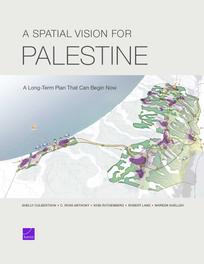A Spatial Vision for Palestine
A Long-Term Plan That Can Begin Now
ResearchPublished Apr 8, 2025
The authors offer a vision for how spatial planning, infrastructure, and resource management in the West Bank and Gaza could better daily lives while supporting the evolution of a future Palestinian state. The vision incorporates six sectors (governance, environment, cities, transportation, energy, and water), about 200 projects, and plans in six locations (Nablus, Jericho, Hebron, Gaza City, North Jordan Valley, and East Jerusalem).
A Long-Term Plan That Can Begin Now
ResearchPublished Apr 8, 2025

The world urgently needs a solution to the Israeli-Palestinian conflict. In parallel with progress toward a long-term political settlement, other indispensable steps for peace and prosperity include infrastructure planning and economic development. In this report, the authors offer a vision for how spatial planning, infrastructure, and resource management in the West Bank and Gaza could better the daily lives of Palestinians now while supporting the evolution of a future Palestinian state. The vision incorporates six sectors (governance, environment, cities, transportation, energy, and water), about 200 projects, and plans in six locations (Nablus, Jericho, Hebron, Gaza City, North Jordan Valley, and East Jerusalem).
The authors propose both quick-win projects that could begin immediately at the local level, even without a political solution, and longer-term, strategic infrastructure investments that would require regional agreements; incrementally, over time, these projects can comprise the essential infrastructure of a future state. The goal of this report is to contribute a tool for dialogue and rational planning, offering an integrated, technical approach to aid diplomacy and economic development.
This research was conducted in the Community Health and Environmental Policy Program within RAND Social and Economic Well-Being.
This publication is part of the RAND research report series. Research reports present research findings and objective analysis that address the challenges facing the public and private sectors. All RAND research reports undergo rigorous peer review to ensure high standards for research quality and objectivity.
This document and trademark(s) contained herein are protected by law. This representation of RAND intellectual property is provided for noncommercial use only. Unauthorized posting of this publication online is prohibited; linking directly to this product page is encouraged. Permission is required from RAND to reproduce, or reuse in another form, any of its research documents for commercial purposes. For information on reprint and reuse permissions, please visit www.rand.org/pubs/permissions.
RAND is a nonprofit institution that helps improve policy and decisionmaking through research and analysis. RAND's publications do not necessarily reflect the opinions of its research clients and sponsors.